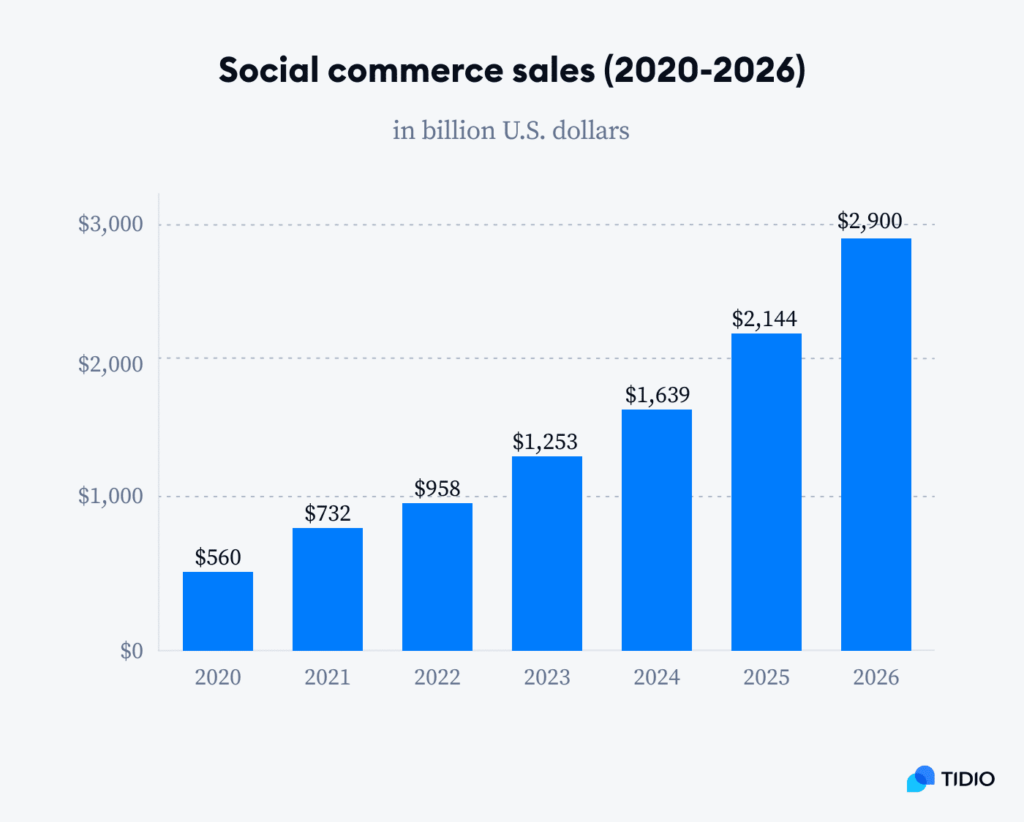Overview of Social Commerce
2024 is the year for social commerce. Based on statistics by Titio, the size of the social commerce market is expected to reach $1.6 trillion in 2024. Merely four years ago, in 2020, the market size reached $560 billion. The growth is undeniably impressive and remarkably swift.

What is Social Commerce?
Social commerce refers to the seamless intersection of social media and e-commerce, where users can discover, research, and purchase products directly within a social media platform. Social commerce provides users with in-app checkout options and a personalised, streamlined shopping experience from discovery to the final purchase.
The ongoing rise in global internet access and widespread smartphone usage is broadening the potential customer base. This enhanced accessibility ensures a higher participation rate, particularly on various social media platforms.
The top social media platforms for social commerce in 2024 are TikTok, Instagram, and Facebook. While Facebook is still expected to be the leading platform in 2024, TikTok is gradually becoming a crowd-favourite, especially for Millennials and Gen Z.
Read more: The Tactical Edge: Unleashing Brands in the Gen Z Era
5 Tips & Techniques to Master Social Commerce:
This strategic move goes beyond boosting sales; it involves integrating brands into consumers’ daily lives, fostering a profound and meaningful connection that surpasses conventional online shopping experiences.
Brands that are still grappling to navigate their way to social commerce must step up. Here are five tips and techniques to successfully tackle this emerging trend.
1. Provide Seamless & Secure Payment Transactions
Transactional efficiency is the backbone of a thriving social commerce ecosystem. Users expect a surge in social payment options, enabling them to purchase directly within their preferred social media apps.
This seamless integration eliminates the need for users to leave the platform to complete a purchase, offering a more convenient and efficient shopping experience.
According to Titio, about 37% of social commerce buyers say they lack trust in the security of their payment information. To address this trust issue effectively, a viable strategy is to maximise transparency. Integration with digital wallets, one-click purchasing, and secure payment gateways help make the payment process efficient and protected.
This amplified convenience not only elevates the overall user experience, but also catalyses spontaneous purchases, thus fostering long-term customer loyalty in the process.
Pro Tips: Invest in cyber insurance to help protect against data breaches and other cybercrimes by covering a business’s liability for any data breaches involving sensitive customer information.
2. Automate Customer Service
By 2024, the incorporation of artificial intelligence (AI) is set to transform customer service within social commerce platforms. Powered by AI, chatbots and virtual assistants offer real-time assistance, answer inquiries, and guide users through shopping. Further, it offers 24/7 support and can learn from past interactions for a personalised service.

This AI-driven customer service ensures an all-in-one experience that swiftly addresses concerns, and plays a crucial role in overall success by elevating user satisfaction and trust.
Other than being cost-effective, AI-powered tools help manage mundane and routine tasks, which allows customer service teams to focus on more complex issues.
Pro Tips: Maximise the potential of your customer service automation by leveraging it for feedback collection. Requesting feedback enables you to gather valuable insights that can be instrumental in enhancing your business.
3. Utilise Short-form Videos
Video content has consistently proven to be a compelling tool for audience engagement, and its reputation is escalating even further within the dynamic landscape of social commerce.
Live streaming and video shopping events are becoming popular as brands utilising this tool to engage with their customers. Brands are leveraging platforms like Facebook Live, Instagram Live, and TikTok Live to showcase their products in real-time, answer questions from viewers, and drive immediate sales.
This trend caters to the demand for authentic and interactive shopping experiences. Allowing customers to witness products in action, ask questions, and receive immediate responses fosters trust and confidence in their purchasing decisions. The synergy of live video and shopping features also creates a dynamic and engaging shopping journey that rivals the in-store experience.
Pro Tips: Optimise videos for different social media platforms. This approach will establish omnipresence, ensuring that your potential audience encounters your content consistently across different channels.

Read more: Unraveling TikTok’s Impact: Retailers in the Age of Social Media
4. Collaborate with Social Influencers
The core of a thriving social commerce strategy lies in the collaboration between brands and social media influencers. Collaborating with influencers can help businesses penetrate their target audience and reach a wider audience, and build trust with potential customers.
These partnerships leverage their considerable following and influence purchasing decisions. Such collaborations enhance brand visibility and foster trust within the influencer’s audience.
Pro Tips: Setting performance tracking tools help indicate if your campaigns are working. The success metrics and KPIs give you insights into which influencers are helping you reach your campaign goals.
5. Promote User-Generated Content (UGC)
One of the best consumer engagements in social commerce is promoting UGC. Brands can initiate UGC campaigns, prompting customers to share feedback, unboxing videos, or creative uses of their purchases.
A good review can significantly influence consumers’ decision-making process, as they are more likely to purchase an item based on authentic and quality reviews. Brands sharing UGC feedback encourages consumers to review products, whether reposting or creating a carousel of positive comments.

By showcasing real-life experiences, UGC bolsters brand authenticity, fosters engagement, and positively influences potential buyers’ perceptions Moreover, UGC amplifies brand reach while nurturing a loyal and involved customer base.
Pro Tips: Real-time unboxing videos are the most viewed user-generated content; they appeal to the consumer’s purchasing experience.
How Can Brands Use Social Commerce to Their Advantage?
The integration of shopping features within social media platforms has become a prominent trend in recent years. This shift reflects the recognition of the powerful role social media plays in influencing consumer behaviour, and the desire to capitalise on this influence for social commerce.
Shopping on social media makes the experience much more interactive than a typical e-commerce platform. Social commerce not only provides an avenue to showcase your products, but also enables real-time customer interaction, creating a sense of urgency and excitement around your brand.
Hence, embracing social commerce can offer significant advantages for brands to thrive in this competitive market. Be it fast-moving consumer goods, niche products, or even upscale items, all eyes are on social commerce, making it one of the most valuable sales channels brands should be part of before it’s too late.


